SMART Goal-Setting
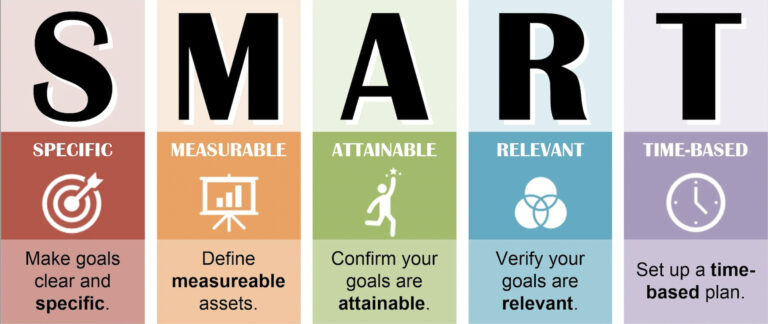
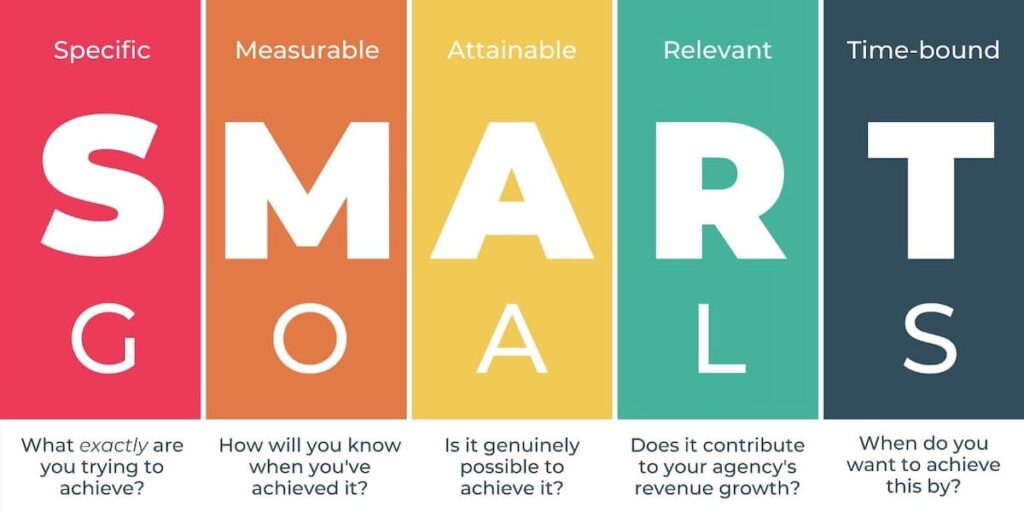
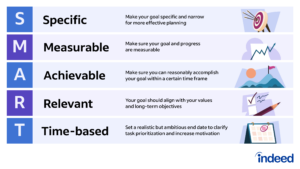
I. SMART Goals
The SMART goal acronym is used in many different settings to help set, achieve, and maintain a variety of different health-related goals.
The SMART Acronym suggests setting goals that are:
SPECIFIC.
MEASURABLE.
ACHIEVABLE/ATTAINABLE.
REALISTIC/RELEVANT.
TIME-BOUND/TIME-BASED.
The SMART Acronym is used with empirical (research-based) support in a variety of healthcare settings, including lifestyle medicine, diabetes-, weight-, and obesity management, rehabilitation, oncology, and additional dietary, exercise-, and behavioral changes.
II. SMARTS GOALS
As a health-coach, I have developed my own acronym – SMARTS – in which the ‘S’ stands for “SAFE.” In my personal life and health coaching alike I take the time to ensure all goals I help clients set and achieve feel (and ARE) safe, healthy, and comfortable for- and within both the client and myself. As a health coach, I am not qualified to help a client set or meet a goal that risks his/her/their or my health or safety in the process.
The SMARTS Acronym suggests setting goals that are:
SAFE.
MOTIVATED.
ACHIEVABLE/ATTAINABLE.
REALISTIC/RELEVANT.
TIME-BOUND/TIME-BASED.
SPECIFIC (& MEASURABLE).
III. SMART-EST GOALS
Since its advent and development, the SMART Acronym has been expanded and adapted based on a variety of different research findings and applications. The most common adaption of the SMART acronym is the SMART-EST acronym for goal-setting, in which the “E-S-T” provides additional suggestions to set and achieve goals that are Evidence-based (e.g., empirically-supported // supported by successful research findings), Strategic (e.g., intentional and with specific instructions), and Tailored to the individual (vs. one-size-fits-all).
The SMART-EST Acronym suggests setting goals that are:
SPECIFIC.
MEASURABLE.
ACHIEVABLE/ATTAINABLE.
REALISTIC/RELEVANT.
TIME-BOUND/TIME-BASED.
–
EVIDENCE-BASED.
STRATEGIC.
TAILORED.
From Vague to SMART-SETS
My first session with a new client often involves helping them transform their often-vague goals (e.g., “I want to lose weight” or “I want to get into shape”) into SMART-SETS. SMART-SETS are goals that are:
- Safe.
- Motivated.
- Attainable.
- Realistic/Relevant.
- Time-Bound.
- /
- Specific (& Measurable).
- Evidence-based.
- Tailored.
- Strategic.
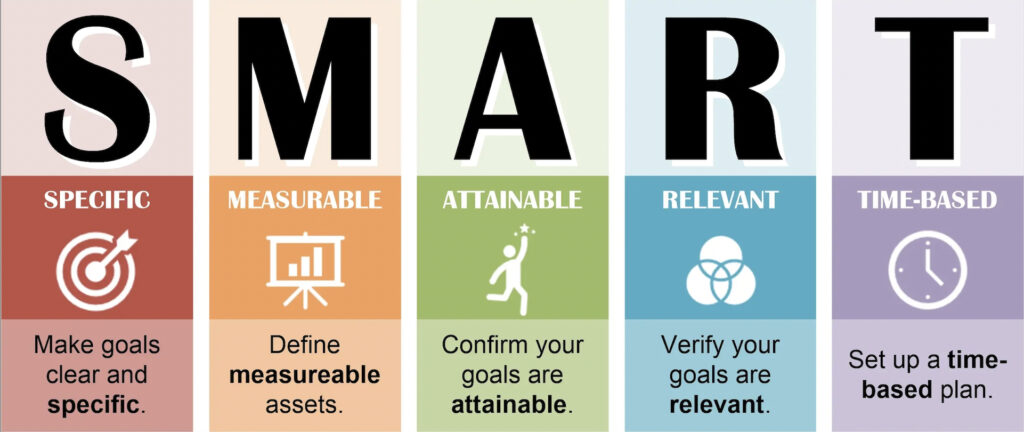
Developing SMART-SETS
Here is an example of how I might use the SMART-SETS goal-setting tool to help a client develop a SMART-SETS goal. A client comes to me with a goal to “lose weight.”
- SAFE/HEALTHY: First, I would use the client’s weight and height to calculate their BMI. This information helps me ensure the client’s weight-loss goals are safe/healthy and will help me work with the client to develop their SMART-SETS.
- MOTIVATED: Second, I would ask the client why s/he/they want(s) to lose weight. This information will provide me with insight into his/her/their motivation.
- ATTAINABLE: Third, I would use the client’s weight, height, BMI, and health history to identify his/her/their healthy “goal weight” range, the amount of weight-loss required to achieve the “healthy weight,” and the amount of time required to safely achieve the weight loss goal(s), based on the clinical rate for safe and healthy weight loss with an additional 25% time buffer factored in.
- RELEVANT: When possible, I work with clients to develop non-weight-focussed goals that align with achieving their “healthy weight” (e.g., “reducing risk for metabolic syndrome by 25%” and “achieving the ability to play outside with my children for 45 min daily” vs. “losing ## pounds” and “achieving a ‘healthy weight’ of ### pounds”).
- TIME-BOUND: Research suggests large goals are most successfully achieved and maintained when broken down into smaller actionable items that can be repeated over time periods of 3 – 6 months with a 25% “time buffer” (Ravishankar & Alpaio 2022).
- Thus, I would tailor the goals identified in step 3 above to fit into a 2.4-month time-period with an additional 0.6-month buffer (so 3 months total).
- I would map out a plan to achieve the ultimate goal(s) (e.g., ‘healthy weight’ and 25% reduction of cardio metabolic risk) in increments of 3 months or less, review the overall plan with the client, then work with the client to tackle one step at a time until we’ve met our goal(s).
- SPECIFIC: I would work with the client ensure the goal(s) we set are measurable and we would develop a specific plan for how and when we will measure and assess goal success.
- For example, when working towards weight-change goals, I suggest clients weigh themselves once weekly at the same time of day on the same day of the week each week. I generally recommend Monday mornings upon waking; after using the bathroom but before breakfast. This method provides a more consistent measure of weight change that also keeps the weight/salience of the goal(s) at an appropriate level.
- EVIDENCE-BASED: After I have developed 1 – 2 long-term outcome-based goal(s) with my client(s) (e.g., “loose ## pounds” to “achieve a weight of ### pounds”) I use research-based practices to develop action items that can be repeated to achieve the overall goal. For example, to achieve weight loss goals, I use evidence-based practices to identify actions my clients that can take that are often related to changes in dietary patterns/habits, exercise/movement, sleep cycles, and stress management.
- TAILORED: I work with the client to identify 2 -3 actionable items that the client can incorporate into his/her weekly routine based on the specifics of his/her life. For example, an action-item for a client with a weight-loss goal and no background of sport/exercise engagement will likely include a different type of engagement with movement than that for a client whose weight-gain is related to a sports injury. Actions related to dietary changes will factor in the client’s food history, allergies, ethnicity, lifestyle, comfort level with meal preparation, and current nutritional status. I may work with one client to find a successful healthy alternative to their morning Caramel Frappuccino and with another to add in an after-dinner snack that can prevent late-night binge eating.
- STRATEGIC: Through bi-monthly coaching calls, I work with the client to find, develop, tweak, and maintain healthy habits that they can repeatedly engage in to achieve their short-term (3-6-month) objectives and long-term goals.

SMART-SETS in Action: Client Case Study

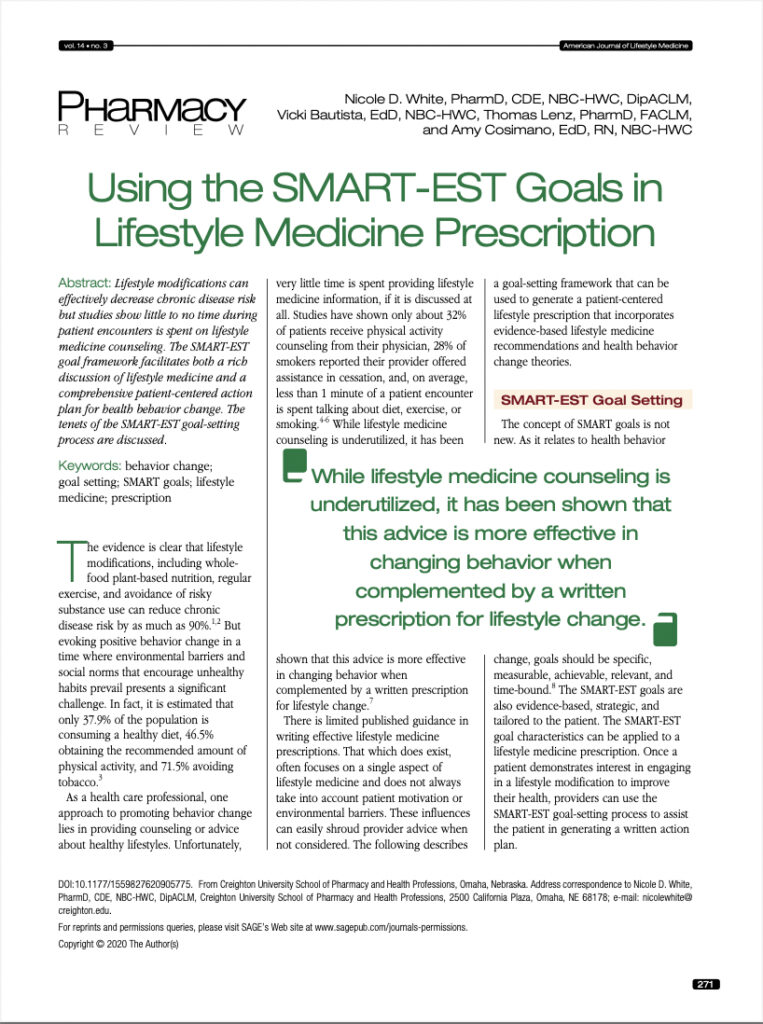
Here is a more specific example//case study of how I might use the SMART-SETS goal-setting tool to help a client develop a few SMART-SETS.
Sherry is a full-time working mother of 3 young children. She has continued to gain weight since her first pregnancy and comes to me after her doctor diagnoses her with obesity and suggests she lose weight to reduce her risk of diabetes, cardiovascular disease, and other health problems.
- I work with Sherry to identify a goal weight based on her height, BMI, and health history.
- I calculate the shortest amount of time Sherry can safely achieve her goal weight in, based on the rate of weekly weight loss that is shown in research to be safe and sustainable.
- I multiply this time period by 1.5 to provide a time-buffer that accounts for set-backs, slumps, plateaus, and other challenges we may encounter.
Based on steps 1 – 3, let’s say I determine that Sherry will need to lose 72 lb., which can be realistically and safely achieved in 1 year. Research shows that goals are best met and sustained/maintained if they are achieved in 6-month increments. Therefore, I would modify Sherry’s long-term weight-loss goal to fit within a 6-month period.
- First, I would suggest Sherry set a long-term goal of achieving her goal weight in 1 year, through the loss of 72 lb (1.5 lb/wk).
- Second, I would suggest Sherry utilize one of my 6-month packages.
- During my first session with Sherry, I would suggest 2 primary SMART-SETS and 3 sub-SMART-SETS goals.
- The two primary SMART-SETS would be: 1) to lose her first 10 pounds in 2 months (by losing 1 – 2 pounds each week) and 2) to achieve this by developing new habits that are easy for her to maintain.
- The three secondary/sub-SMART-SETS goals would provide more specific suggestions on how to meet the first two SMART-SETS. I would work with Sherry to find three new habits that promote her weight and health goals. These might be: 1) 10 jumping jacks first thing in the morning every morning. 2) Swapping her usual Starbucks breakfast for a homemade smoothie each Monday and Wednesday. 3) Spending 30 minutes batch-cooking/meal-prepping at 7p each Sunday evening. 4) Listening to a guided yoga nidra or meditation YouTube video before bed each Thursday.
During our first session, Sherry and I will further discuss how to measure these goals. We will identify- and create plans for potential setbacks and pitfalls related to these goals. We will also set up strategies for social support and accountability.
We will continue to check in and expand on Sherry’s goals as she achieves her weight loss and her overall health, happiness, and self-efficacy grow.

St. Patrick’s Day Hot Take: Choose Cabbage Over Corned Beef
As we don our festive hues of green, St. Patrick’s Day brings a fresh take on tradition with a focus on cabbage, a leafy powerhouse

Bountiful Greens: A Nutrient-Rich Delight
In the treasure trove of nutrition and diet, there lays a brilliant emerald: dark leafy greens. Whether it’s St. Patrick’s Day or any ordinary day,

Let’s Talk About Smoothies II
Let’s Talk About Smoothies Smoothies are all the rage these days, but are they really all they’re cracked up to be? From the green vegetable


It’s hard to come by experienced people about this topic,
however, you sound like you know what you’re talking about!
Thanks
Glad to hear your found this blog helpful! SMART-SETS are central to my health coaching practice. I’m happy to discuss further; feel free to reach out or book a consult! – Brenna